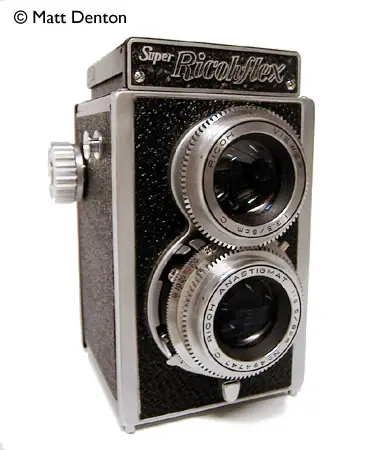- Produced 1956-? Riken Optical Co., Ltd. Japan
- Film type 120
- Picture size: 6cm x 6cm
- Weight 27.4oz (776.8g)
- Lens (taking) Ricoh Anastigmat 80mm f3.5 (stops to f16)
- Filter Size 36mm push-on
- Focal range 3.6′ to infinity
- Shutter Riken
- Shutter speeds B, 1/10 – 1/200
- Viewfinder TLR
- Exposure meter none
- Accessory shoe, PC sync (syncs at all speeds)
- Available 35mm accessory back
Overview
This is exactly what it looks like, a low-end but well-made TLR that falls alongside the Lubitels for entry-level simplicity and at the same time sharp picture-taking. I know Ricoh isn’t one of the names you think of first when you think of cameras, but they made good ones, and this is no exception. It’s not on a par with the countless Japanese Rolleiflex copies, but then it’s not a Rolleiflex copy, it’s a Lubitel copy (more accurately a Kodak Reflex copy), with a steel body rather than plastic or Bakelite. There is a nicer model VII with a Seikosha shutter (same as on many Minolta Autocords) but this one is perhaps more collectible because of the available 35mm adapter though I don’t know why you’d want to do that, seriously. If you want a Ricoh Rolleiflex copy look at the Ricohflex Dia or Diacord, a very collectible higher-end model (particularly the ‘L’ model). I’ve also seen another version of the Super Ricohflex with a different built-in back, probably a model-year variation.
THAT SAID, this is a good little camera and takes nice sharp pictures. Nice bokeh too. The Lubitel had a shutter very like the Voigtlander Brilliant, this has an interesting single-lever shutter that cocks when you press the lever clockwise and fires when you press it counterclockwise, very efficient. Focusing is exactly as on the Lubitel, with the two lenses geared together rather than a moving platform as on the Rolleiflex and its spawn. It’s not as elegant as a focus knob but it works.
One interesting thing that sets this camera apart is that the inside comes out just like on a box camera. This is how you convert it to take 35mm, by replacing the ‘cone’ with a 35mm module called the “Ricoh Color-Back” or “Ricohkin”. The wind knob is marked for 35mm frames, and apparently the Color-Back has automatic frame counting built in, but if you’re using 120 film you’re stuck using the red window for film advancing. Keep it closed with the slide cover when not actually winding on, so as not to fog the film.
Tips & Tricks
Red window frame advance, single-lever shutter. The back door opens with a sliding lever and hole-and-pin locking mechanism. Film loading is just like on a box camera, you pull the wind knob out and remove the ‘cone’ or internal frame, then the film pops in below and the takeup spool goes on top. Geared focusing, note that if unused for a long time the grease on the cogs can thicken and prevent the rings from turning or at least cause them to move stiffly.
Related Links
- Here’s the online manual at butkus.org/chinon supersite
- Classic Cameras’ take on the Super Ricohflex
- info on the whole Ricohflex lineage
